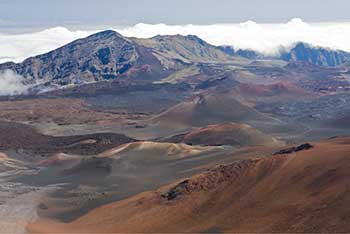| Hawaiian Volcanic Rocks |
 |
| Haleakala. |
Haleakala National Park
Haleakala National Park is renowned for its inspiring volcanic landscapes resulting from the constant clash of the constructive force of volcanism and the destructive forces of erosion. It is a special place vibrating with stories of ancient and modern Hawaiian culture that protects the bond between the land and its people.Haleakala is a shield volcano, on the Island of Maui, that has been above the ocean surface for about 1.5 million years. The Hawaiian Islands are at the southeastern end of a chain of volcanoes that began to form more than 70 million years ago. Many of these volcanoes formed islands that have subsided and eroded beneath sea level, and some of the old volcanoes probably never reached sea level. Each Hawaiian island is made of one or more volcanoes, which first erupted on the sea floor and only emerged above the ocean's surface after countless eruptions.
The largest and most southeastern island of the chain, Hawai`i, consists of five volcanoes. Kilauea, Mauna Loa, and Hualalai have erupted in the past 200 years. Lo`ihi, the youngest volcano of the Hawaiian Volcanic Chain, is still about 1,000 meters beneath the ocean's surface. Haleakala is the only other Hawaiian volcano to have erupted since the late 1700's. It has witnessed at least ten eruptions in the past 1,000 years, and numerous eruptions have occurred there in the past 10,000 years. It is expected that the volcano will erupt sometime in the future.
Haleakala National Park is the most visited part of East Maui. The Hawaiian name Hale-a-ka-la (lit., house of the sun), is now nearly synonymous with the entire shield of East Maui volcano. Early Hawaiians, however, applied the name only to the summit area, the site where the demigod Maui snared the sun and forced it to slow its journey across the sky.
The oldest lava flow exposed on East Maui is about 1.1 million years in age. It is part of a sequence of flows emplaced near the end of shield building on East Maui. The time estimated to build a volcano from ocean floor to the end of its shield-building stage is thought by some scientists to be about 0.6 million years. East Maui volcano probably began its growth about 2.0 million years ago.
Volcanism of the past 30,000 years on East Maui has been focused along the southwest and east rift zones. These two volcanic axes together form one gently curving arc that passes from La Perouse Bay (southwest flank of East Maui) through Haleakala Crater to Hana on the east flank. The alignment continues east beneath the ocean as Haleakala Ridge, one of the longest rift zones along the Hawaiian Islands volcanic chain. The on-land segment of this lengthy volcanic line of vents is the zone of greatest hazard for future lava flows and cindery ash.
